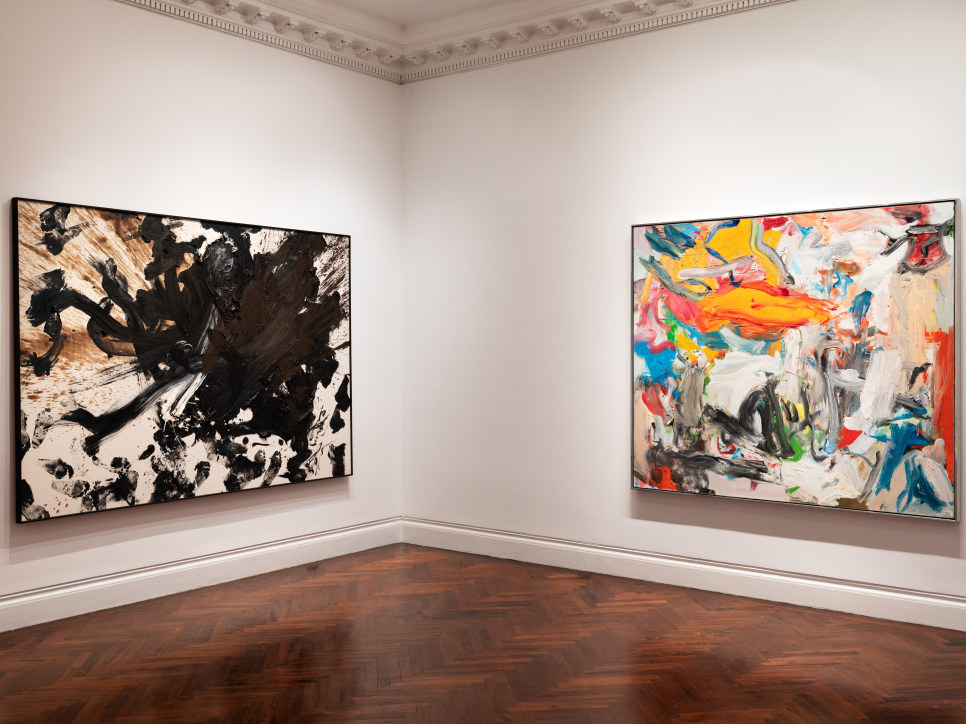
Willem de Kooning, a leading figure of Abstract Expressionism, was born on April 24, 1904 in Rotterdam, the Netherlands. De Kooning entered the Rotterdam Academy of Fine Arts & Letters in 1916, where he studied until 1925. De Kooning then immigrated to the United States in 1926, and worked as a house painter in Hoboken, New Jersey before relocating to New York City in 1927. Once in New York, de Kooning worked a variety of odd jobs until 1935, when he was employed by the mural and easel divisions of the WPA Federal Art Project. After this time, de Kooning painted full-time, and was influenced primarily by Cubism and Surrealism, and artists such as Picasso and Gorky, with whom he shared a studio.
De Kooning's first solo exhibition was held at the Egan Gallery, New York in 1948, establishing the artists' reputation. The show consisted largely of black-and-white abstract paintings of densely worked oil and enamel. In the early 1950s, he began to paint his now celebrated “Women” series. These aggressively painted female figures shocked the art world when they were first exhibited, as much for the way they were painted as for de Kooning’s return to figuration, which many in his circle deemed as a betrayal of Abstract Expressionist principles. However, the Museum of Modern Art, New York saw their importance, and purchased “Woman I” (1950-1052) in 1953.
The 1960s yielded works of abstract urban landscapes and a new group of “Women”. In 1963, de Kooning moved to the town of Springs, dividing his time between Long Island and Manhattan before permanently relocating to Springs in 1971. The light and landscape of the East Hampton town reminded him of Holland, and opened up his canvases to include softer colors and more loosely painted forms. Paintings from the 1980s continue this thread even further, with large swaths of subtly toned white canvas augmented by ethereal, ribbon-like strokes of color.
In 1968, the Stedelijk Museum, Amsterdam held a retrospective of de Kooning's work, for which the artist returned to the Netherlands for the first time since 1926. After beginning his first sculpture work in 1969 while in Rome, the Walker Art Center, Minneapolis organized an exhibition of the artists' sculptures in 1974, which travelled throughout the United States. The Solomon R. Guggenheim Museum, New York followed in 1979 with an exhibition of the artists' recent works, and in 1997 the Museum of Modern Art, New York, honored the artist with a retrospective, followed again by a retrospective in 2012. His works can be found in the permanent collection of the Stedelijk Museum, Amsterdam; the Tate Modern, London; the National Gallery of Australia, Canberra; the Museum of Modern Art, New York; the Metropolitan Museum of Art, New York; the Art Institute of Chicago; and the National Gallery of Art, Washington D.C., among many others.
Willem de Kooning died on March 19, 1997 on Long Island.

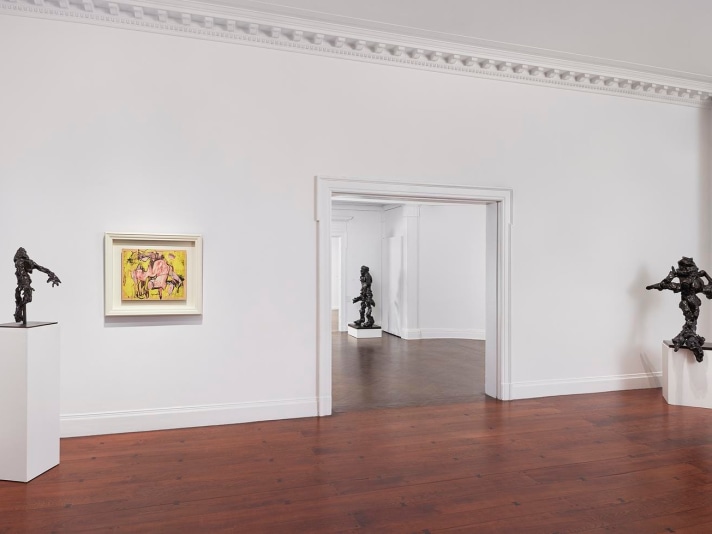
By: Tom McGlynn
It’s been 22 years since Willem de Kooning’s death at 93. His long and prodigiously productive career was lately most fully examined in a retrospective held between 2011–12 at MoMA. He may be, at this point, one of the most examined artists of the 20th century. Fortunately, his work has, for the most part, withstood the historic “seating” that such scrutiny might instruct. The artist’s own phrase for the visual capture of life’s vital yet elusive moments, “slipping glimpses,” can be applied to the intransigent present his work perpetually announces.
Willem de Kooning was one of the Abstract Expressionists who, along with Jackson Pollack, wrestled the art crown from Paris following World War II and brought it to New York. This exhibit traces the full arc of his career from the 40s to the 80s as only the Mnuchin Gallery, with its unparalleled De Kooning resources, can provide.
Colorful, ebullient, the depth and quality of work on display from this major figure in Modern Art could scarcely be topped by any museum in the world.
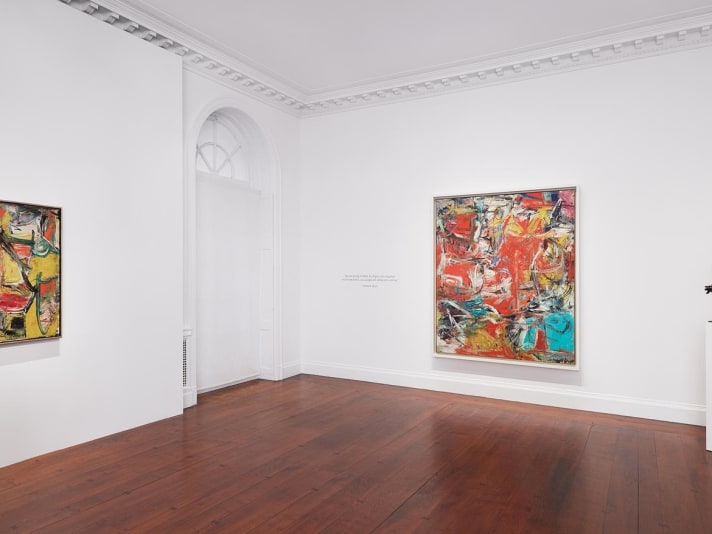
By: Stephen Ellis
When he was in the mood, Willem de Kooning had a gift for titles both memorable and unconfining. Gotham News, Suburb in Havana, and (my favorite) Rosy-Fingered Dawn at Louse Point provide catchy handles for images as elusive as they are beautiful. Alas, he wasn’t always in the mood; he stuck Composition (1955)—one of the most glorious of all Abstract Expressionist paintings—with one of his least imaginative titles. It is on loan from the Guggenheim for the smartly curated small retrospective at the Mnuchin Gallery’s graceful 1914 townhouse.
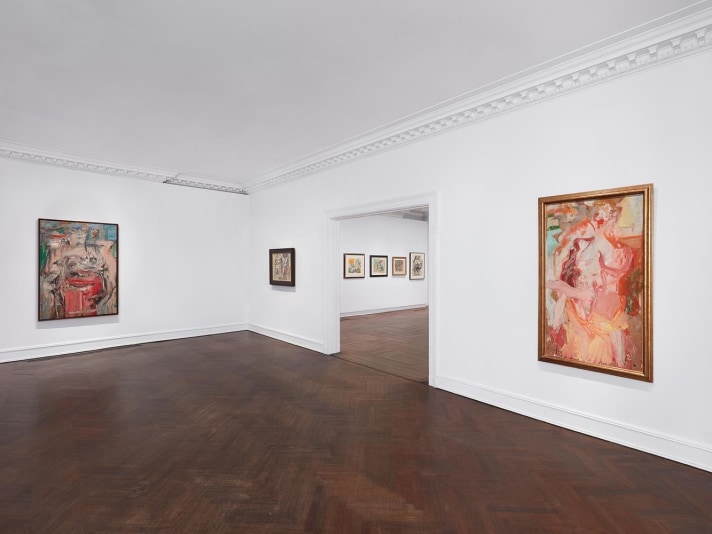
By: James Panero
A clash of the titans rages on the Upper East Side. Now at Mnuchin Gallery, “De Kooning: Five Decades” continues the titanomachy of the twentieth-century art gods—and the mortal women who loved them.
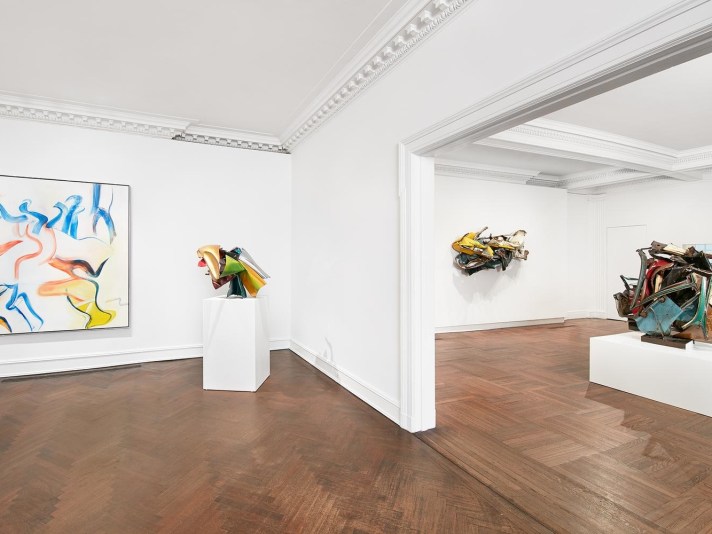
By Isabella Mason
Mnuchin Gallery in New York is hosting an exhibition “Chamberlain/de Kooning” that will be on view through January 28, 2017.
“Chamberlain/de Kooning” is an exhibition of sculptures by John Chamberlain and paintings by Willem de Kooning, focussing specifically on the visual dialogue between Chamberlain’s career and the late paintings by de Kooning made during the 1970s and 1980s. Chamberlain was deeply influenced by the Abstract Expressionist painters, particularly de Kooning, which reflected in his sculptures that translates the energy, gesture, and action-based processes of Abstract Expressionism into three-dimensional forms. The exhibition brings together his twelve sculptures along with seven paintings by de Kooning. The sculptures represent two distinct episodes of Chamberlain’s career. Works spanning from 1958 to 1964 illustrate the period where the artist starts the use of his signature medium of welded steel, while the later group of works hails from the mid-1970s, marking Chamberlain’s return to his use of automobile parts. The paintings by de Kooning also represent two iconic bodies of his late work, including four major examples of abstract landscape paintings from the 1970s, in which the artist’s vibrating strokes of bright blues and flesh pinks evoke the sea, sand, and coastal light of East Hampton, and a group of paintings from the 1980s where he transforms his richly impasto canvases of the previous decade into luminous compositions in which ribbons of color ripple and curve across pale, ethereal backdrops. Presented together, the crevices contained in Chamberlain's crumpled sheets of painted enamel evoke the layered folds of color in de Kooning's canvases of the 1970s, while the gleaming, rounded curves of the sculptor's bent fenders echo the smoothly arcing lines of the painter's works from 1980s.
